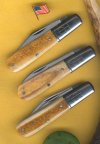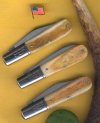-
The BladeForums.com 2024 Traditional Knife is available! Price is $250 ea (shipped within CONUS).
Order here: https://www.bladeforums.com/help/2024-traditional/
You are using an out of date browser. It may not display this or other websites correctly.
You should upgrade or use an alternative browser.
You should upgrade or use an alternative browser.
Stag handle care
- Thread starter tongueriver
- Start date
tongueriver
Gold Member
- Joined
- Dec 28, 2007
- Messages
- 5,397
I like that idea. Leftovers down the hatch! With a little honey, of course.With Stag, I've had tidy results by using Tea dye, it has to be strong though like the British/Irish drink it.
Will Power
Gold Member
- Joined
- Jan 18, 2007
- Messages
- 33,576
Some of you might laugh...

Nor this CASE bone which was a horrid pink slime colour pretending to be 'Salmon' Refreshed with Tea

Last edited:
sf fanatic
Platinum Member
- Joined
- Apr 4, 2017
- Messages
- 5,279
Charlie, please excuse my ignorance but is the pith where the handle meets the bolster? Thanks.These third cut Stags were treated with Super-Glue to prevent shrinkage across the pith!! Very effective!!View attachment 2537048View attachment 2537049
eisman
Platinum Member
- Joined
- Sep 9, 2009
- Messages
- 6,989
Model makers use a cyanoacrylate glue to fill small holes. This would be better than an epoxy. It can be had thin, or as a gap filler. Use it as a sealer, it's thin enough you won't have to reshape the material. Gorilla glues, which are fantastic for holding, have an issue with expansion, which you probably don't want, but that's how they cure. Thin epoxies work well when finishing but have variable drying times and if not kept directly where you want them require sanding down of the excess and flow marks.
Linseed oil has been mentioned, and it's been used in gunstocks for a long time, but I dislike it (as a filler, it makes a good finish) because it takes too long to cure and will soften in heat, even after years. What I used for a pore filler when doing gunstocks was Varathane Oil, which is an epoxy type finish for furniture. I like it as a base coat because it penetrates, and gets dead hard, filling all the pores. when an oil (or gloss) finish is applied over that you don't have any little spots that need fixing unless you sand too deep. It also works well on fresh checkering, better than the citrus or nut oils often used, because it does fill the pores and won't allow dirt in.
Just my $0.02.
Linseed oil has been mentioned, and it's been used in gunstocks for a long time, but I dislike it (as a filler, it makes a good finish) because it takes too long to cure and will soften in heat, even after years. What I used for a pore filler when doing gunstocks was Varathane Oil, which is an epoxy type finish for furniture. I like it as a base coat because it penetrates, and gets dead hard, filling all the pores. when an oil (or gloss) finish is applied over that you don't have any little spots that need fixing unless you sand too deep. It also works well on fresh checkering, better than the citrus or nut oils often used, because it does fill the pores and won't allow dirt in.
Just my $0.02.
Chui
Gold Member
- Joined
- Jul 10, 2012
- Messages
- 3,340
- yup, correct, more effective than using coffeeWith Stag, I've had tidy results by using Tea dye, it has to be strong though like the British/Irish drink it.
Will Power
Gold Member
- Joined
- Jan 18, 2007
- Messages
- 33,576
Yeah..look what it does to tea-cups (if you drink it strong style) and your teeth (the Beaver look....) if it's left soaking 
waynorth
Dealer / Materials Provider
- Joined
- Nov 19, 2005
- Messages
- 33,346
The pith is the core of the Stag. It is porous, unlike the outer part of the antler which is solid. "3rd Cut exposes the pith along the surface of the handles, making varying, and I think, interesting textures, but is slightly less stable than the outer features of traditional Stag. Hence, a filler (superglue), is needed!!Charlie, please excuse my ignorance but is the pith where the handle meets the bolster? Thanks.
The purpose of using the rejected parts of the antler in Barlow construction carries on the tradition of a less expensive working knife that brought about the Barlow!!
Horsewright
Knifemaker / Craftsman / Service Provider
- Joined
- Oct 4, 2011
- Messages
- 13,724
Thought some folks might like to see some of the process:
Just out of the PP bath:

Drying after the clear coat:

Four scales cut off a section of elk antler. A square of pith is left:

Here on the end cuts on these sections ya can see the pith:

I do this quite a bit:


Elk is one of my most popular handle materials:


Center knife above:


I have used coffee before as a dye on red deer (cousin of elk). It worked but not well. I've also used the leather dyes (having some around). They produced unnatural colors. Kinda some pinkish/reddish/oranginish where it was suppose to be white.
Just out of the PP bath:

Drying after the clear coat:

Four scales cut off a section of elk antler. A square of pith is left:

Here on the end cuts on these sections ya can see the pith:

I do this quite a bit:


Elk is one of my most popular handle materials:


Center knife above:


I have used coffee before as a dye on red deer (cousin of elk). It worked but not well. I've also used the leather dyes (having some around). They produced unnatural colors. Kinda some pinkish/reddish/oranginish where it was suppose to be white.
- Joined
- Oct 18, 2018
- Messages
- 8,475
Thought some folks might like to see some of the process:
Just out of the PP bath:

Drying after the clear coat:

Four scales cut off a section of elk antler. A square of pith is left:

Here on the end cuts on these sections ya can see the pith:

I do this quite a bit:


Elk is one of my most popular handle materials:


Center knife above:


I have used coffee before as a dye on red deer (cousin of elk). It worked but not well. I've also used the leather dyes (having some around). They produced unnatural colors. Kinda some pinkish/reddish/oranginish where it was suppose to be white.
Dave, do you freehand cut the scales on your Portaband saw? or use a sawing jig of sorts? do you flatten them on your disk? They look very nice and even (if they are just sawed)
I really want to play, and try some elk scales. It's a goal of mine to make a knife with them this year. Most of my handles are pretty big, but I think I have a couple models that I could get to work.
All your pics are Very inspirational!!! Thank You.
Horsewright
Knifemaker / Craftsman / Service Provider
- Joined
- Oct 4, 2011
- Messages
- 13,724
Yes sir I just freehand them and then flatten on a flat disc. If you grind a reverse angle on each end (with the exterior edge further out than the interior edge), ya can get a good grip on them and sand them fairly thin with out too much finger tip sanding. Thats an older pic and I was still using a 14 inch free standing bandsaw for handle materials. I have since switched to just using the portaband on a SWAG table. I gave the 14 incher away, I so much didn't need it and the portaband really does do all my cutting needs. Way safer too. When ya get going and ya have any questions don't hesitate. Just cut bigger pieces for your knives. The last finished knife pictured above is my Sonoran Camp Knife. It is10"oal and in the first pic of materials and blades ready to put together, the two knives on the left are two of my Tehachapi Saddle Bowie model. They are 14.25" oal. I trade for all my elk sheds btw. Bet you could too. I traded a rancher from up north for this unique elk shed recently.Dave, do you freehand cut the scales on your Portaband saw? or use a sawing jig of sorts? do you flatten them on your disk? They look very nice and even (if they are just sawed)
I really want to play, and try some elk scales. It's a goal of mine to make a knife with them this year. Most of my handles are pretty big, but I think I have a couple models that I could get to work.
All your pics are Very inspirational!!! Thank You.

He's wanting to learn how to make his own saddles so I made him this in trade:


All my roundknives cut out there own sheath before they go.
Here in California we are required by law to only use sheds for craftsmanship purposes. Not sure of the law in other places.
Last edited:


